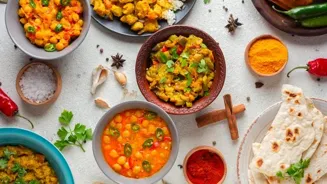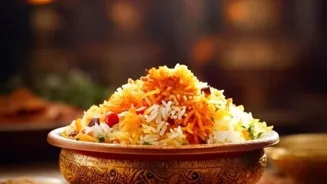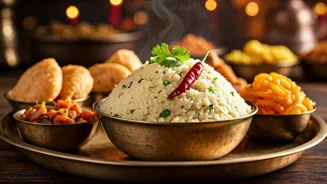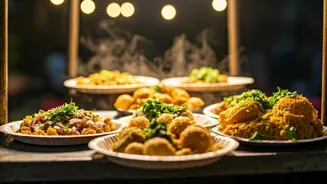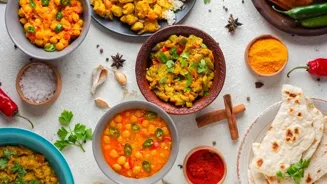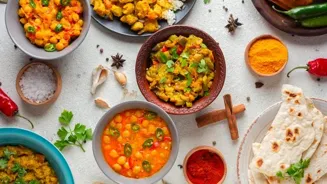Unveiling India's Street Food: Origins & Stories of 7 Iconic Dishes. Dive into the culinary tapestry!
India, a land of vibrant culture and diverse traditions, also boasts a street food scene that is unmatched
in its variety and flavour. From the bustling streets of Mumbai to the narrow lanes of Delhi, every corner of India offers a unique culinary experience.
Street food in India is not just about satiating hunger; it's a celebration of flavours, a social experience, and a journey through the country's rich culinary heritage.
Let's embark on a delicious journey to uncover the origins and stories behind seven iconic Indian street food dishes, all vegetarian.
Pani Puri: The King of Street Snacks
Pani Puri, also known as Gol Gappa or Puchka in different parts of India, is arguably the most popular and loved street food across the country. These small, crispy, hollow puris are filled with a tangy, spicy, and flavourful mixture of tamarind water (pani), potatoes, chickpeas, and spices.
The burst of flavours with every bite is what makes Pani Puri so irresistible.
The origins of Pani Puri are a bit murky, with several different stories and theories floating around.
However, the most widely accepted theory links its origins to the ancient kingdom of Magadha (present-day Bihar) in India. It is believed that Pani Puri was initially created as a means to tackle constipation among the royals.
The dish eventually spread across India, evolving and adapting to regional tastes and preferences. Today, Pani Puri is enjoyed by people of all ages and backgrounds, making it a true representation of India's culinary unity.
Different regions have their own variations of the pani, some sweet, some spicy, some herby, but the basic concept remains the same - a burst of flavour in a bite-sized package.
The social aspect of eating Pani Puri is also important, you will often see groups of people gathered around a street vendor, eagerly awaiting their turn to devour these flavour bombs.
Aloo Tikki: The Humble Potato Patty
Aloo Tikki, a popular street food snack, is made from mashed potatoes, spices, and sometimes peas formed into patties and shallow-fried until golden brown and crispy.
It is typically served with chutneys, such as mint-coriander chutney and tamarind chutney, and sometimes topped with yogurt and sev (crispy chickpea noodles), giving it a mix of textures and different tastes.
The warm, comforting flavour of the potato combined with the tangy chutneys and crispy sev makes this street food a favourite among many.
Aloo Tikki is believed to have originated in Uttar Pradesh (UP), India. UP has long been known for its potato production.
The dish likely evolved from the simple potato patties cooked in households and was gradually sold by street vendors, gaining popularity over time. Different regions have adapted the recipe, but the basic ingredients of potato and spices remain consistent.
In North India, Aloo Tikki is often served with chole (chickpea curry), creating a more substantial meal. The popularity of Aloo Tikki has also spread beyond India, with variations appearing in other countries with Indian diaspora communities.
This street food is a great example of how simple ingredients can be transformed into a delicious and satisfying snack. The ease of preparation and affordable price have further contributed to its widespread popularity.
Bhel Puri: A Symphony of Textures and Flavours
Bhel Puri is a light and refreshing street food snack made from puffed rice, vegetables like onions, tomatoes, and potatoes, and a variety of chutneys.
It is known for its symphony of textures and flavours, combining the crunchiness of the puffed rice with the sweetness of the tamarind chutney, the spiciness of the green chutney, and the tangy flavours of the vegetables and spices.
Bhel Puri is believed to have originated in Mumbai, Maharashtra, India. It is said that the dish was first created by street vendors in the city, who sought to create a quick and satisfying snack for the working class.
The combination of readily available ingredients like puffed rice, vegetables, and chutneys made it a popular and affordable option. Over time, Bhel Puri became synonymous with Mumbai's street food culture. This savoury and crunchy snack brings out a flavour that one must experience.
Every bite offers a new taste, which makes it interesting to eat. There are many variations of Bhel Puri available in India to experience.
Dabeli: The Kutch Special
Dabeli, also known as Kutchi Dabeli, is a popular street food snack originating from the Kutch region of Gujarat, India. It is made by stuffing a special potato mixture between two slices of a small burger bun (ladi pav) and topping it with chutneys, pomegranate seeds, sev, and roasted peanuts.
The result is a sweet, spicy, and tangy snack that is both satisfying and flavorful.
Dabeli is credited to Keshavji Gabha Chudasama, a resident of Mandvi, Kutch, who started selling it in 1960. He initially sold it for one anna (a small denomination of Indian currency).
The dish gained popularity quickly, and soon, it became a staple street food in Kutch and other parts of Gujarat. The name "Dabeli" is derived from the Gujarati word "dabelo," which means "pressed." This refers to the way the potato mixture is pressed into the bun.
The unique blend of spices and the sweet-spicy-tangy flavor profile sets it apart from other Indian street food snacks. The freshness of the pomegranate seeds and the crunchiness of the peanuts add another layer of complexity to the snack.
Vada Pav: Mumbai's Iconic Burger
Vada Pav is considered the soul of Mumbai street food. It consists of a deep-fried potato patty (vada) spiced with spices and gram flour, placed inside a soft bread roll (pav) slathered with chutneys.
It is a quick, affordable, and satisfying snack that captures the essence of Mumbai's fast-paced life.
Vada Pav's origins can be traced back to Ashok Vaidya, a street vendor who started selling it near Dadar railway station in Mumbai in the 1960s.
With the textile mills and factories in the area, workers needed a quick and cheap meal during their lunch break. Ashok Vaidya saw an opportunity and created a dish that combined the Maharashtrian potato vada with the readily available bread rolls.
Vada Pav quickly gained popularity among the working class and eventually became a street food staple throughout Mumbai. The simple combination of flavors and textures, the convenience of eating it on the go, and its affordability, have contributed to its enduring popularity.
Today, Vada Pav is not just a snack, but a symbol of Mumbai's culinary identity.
Pav Bhaji: A Hearty Street Food Meal
Pav Bhaji is a popular street food dish from Maharashtra, India, consisting of a thick vegetable curry (bhaji) usually made with potatoes, cauliflower, peas, carrots, and tomatoes, cooked in butter and spices. It is served with buttered pav (bread rolls) that are toasted on a flat griddle.
Pav Bhaji is a hearty and flavorful meal that is perfect for lunch or dinner.
Pav Bhaji is believed to have originated in Mumbai in the 1850s. It is said that textile mill workers needed a quick and nutritious meal during their lunch breaks, which led to the creation of Pav Bhaji.
Street vendors would combine leftover vegetables and spices to create a flavorful curry, which was served with buttered pav for a filling and affordable Meal. Over time, Pav Bhaji gained popularity across Maharashtra and eventually became one of India's most beloved street food dishes.
The heavy use of butter, vegetables, and spices make it a flavourful snack. Different regions of the country have adapted their own versions of the dish. However the dish continues to sell across Mumbai.
Momos: Steamed Dumplings of Joy
Momos, though originally from Tibet and Nepal, have become a very popular street food in India, particularly in the northern and eastern regions. These are steamed dumplings filled with a stuffing, typically made of vegetables, and served with a spicy dipping sauce.
Momos are light, delicious, and easy to eat. They became so popular that they are often seen at different street stalls across the country.
The introduction of Momos to India can be attributed to the Tibetan diaspora, who settled in India after the Chinese annexation of Tibet in 1950s.
These refugees migrated to India, primarily to states like Himachal Pradesh, Sikkim, and Darjeeling, where the dish gained popularity. Over time, Momos spread to other parts of India, adapting to local tastes. Now you can see varieties ranging from steamed to fried.
This quick and easy dish has quickly become people's favorite.
AI Generated Content. Glance/InMobi shall have no liability for the content